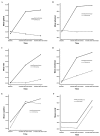Effects of systematic rehabilitation programs on quality of life in patients undergoing lung resection
- PMID: 24649148
- PMCID: PMC3956241
- DOI: 10.3892/mco.2012.31
Effects of systematic rehabilitation programs on quality of life in patients undergoing lung resection
Abstract
The aim of this study was to investigate the effects of systematic rehabilitation programs on the quality of life (QOL) in patients undergoing lung resection of malignant lung lesions. In this prospective population-based cohort study, QOL in patients prior to, as well as 3 and 6 months after surgery, was investigated. Using a single-group design, 48 patients (7 females and 41 males) with suspected operable lung cancer were included in this study. The demographic characteristics and the clinical history of the patients were recorded. QOL [assessed using the European Organization for Research and Treatment of Cancer Quality of Life Questionnaire Core 3.0 (EORTC QLQ-C30)] was evaluated at baseline (immediately before), and 3 and 6 months after surgical resection. The systematic rehabilitation program, including breathing control, breathing exercises, relaxation training, upper and lower extremity exercises, mobilization and additional incorporating physiotherapy programs, was designed to meet each patient's individual needs. The χ2 and Fisher's tests showed no statistically significant difference in the two groups in terms of age, gender, behavior, clinical stage, adjuvant therapy and Karnofsky scores. QOL analysis of baseline was homogeneous between the experimental and control groups. Three months after the rehabilitation process, the experimental group demonstrated an increase in the general QOL functional scales and a decrease of symptom scales compared to the control group. These changes were statistically significant in the functional scales of global health (P<0.01), physical function (P<0.01), role function (P<0.01), emotional function (P<0.05), symptom scales of fatigue (P<0.01) and appetite loss (P=0.001). Six months after the intervention, the outcome was the same as 3 months after the intervention in functional scale domains. However, in the symptom scales, the symptoms in the experimental group were improved compared to the control group. The domains had been significant in the scales of fatigue (P<0.001), dyspnea (P<0.001), pain (P<0.001), insomnia (P<0.001), appetite loss (P<0.001) and constipation (P<0.001). Therefore, the two groups demonstrated a statistically significant difference in 10 domains. In addition, the experimental group demonstrated a significant recovery. In conclusion, systematic rehabilitation programs may be beneficial for lung cancer patients by reducing respiratory symptoms, pain, and improving health-related QOL. Consequently, the findings of this study suggest that systematic rehabilitation programs, prepared by taking into consideration the individual requirements of lung cancer patients, should be incorporated into lung cancer treatment.
Keywords: European Organization for Research and Treatment of Cancer Quality of Life Questionnaire version 3.0; lung cancer; quality of life; systematic rehabilitation programs.
Figures



Similar articles
-
Evaluating quality of life and pulmonary function of long-term survivors of non-small cell lung cancer treated with radical or postoperative radiotherapy.Am J Clin Oncol. 2009 Feb;32(1):65-72. doi: 10.1097/COC.0b013e31817e6ec2. Am J Clin Oncol. 2009. PMID: 19194128
-
Cross-Sectional Patient-Reported Outcome Measuring of Health-Related Quality of Life With Establishment of Cancer- and Treatment-Specific Functional and Symptom Scales in Patients With Penile Cancer.Clin Genitourin Cancer. 2018 Dec;16(6):e1215-e1220. doi: 10.1016/j.clgc.2018.07.029. Epub 2018 Aug 11. Clin Genitourin Cancer. 2018. PMID: 30201215
-
Effects of intensive physiotherapy on Quality of Life (QoL) after pancreatic cancer resection: a randomized controlled trial.BMC Cancer. 2022 May 9;22(1):520. doi: 10.1186/s12885-022-09586-1. BMC Cancer. 2022. PMID: 35534822 Free PMC article. Clinical Trial.
-
Interactions of Spiritual Well-Being, Symptoms, and Quality of Life in Patients Undergoing Treatment for Non-Small Cell Lung Cancer: A Cross-Sectional Study.Semin Oncol Nurs. 2021 Apr;37(2):151139. doi: 10.1016/j.soncn.2021.151139. Epub 2021 Mar 24. Semin Oncol Nurs. 2021. PMID: 33771405 Review.
-
Postoperative Symptom Burden in Patients Undergoing Lung Cancer Surgery.J Pain Symptom Manage. 2022 Sep;64(3):254-267. doi: 10.1016/j.jpainsymman.2022.05.016. Epub 2022 Jun 2. J Pain Symptom Manage. 2022. PMID: 35659636 Free PMC article.
Cited by
-
Effect of Exercise and Pulmonary Rehabilitation in Pre- and Post-Surgical Patients with Lung Cancer: Systematic Review and Meta-Analysis.Medicina (Kaunas). 2024 Oct 22;60(11):1725. doi: 10.3390/medicina60111725. Medicina (Kaunas). 2024. PMID: 39596911 Free PMC article.
-
The structural equation model on self-efficacy during post-op rehabilitation among non-small cell lung cancer patients.PLoS One. 2018 Sep 20;13(9):e0204213. doi: 10.1371/journal.pone.0204213. eCollection 2018. PLoS One. 2018. PMID: 30235301 Free PMC article.
-
Effects of progressive muscle relaxation training on sleep and quality of life in patients with pulmonary resection.Sleep Breath. 2018 Sep;22(3):695-702. doi: 10.1007/s11325-017-1614-2. Epub 2017 Dec 30. Sleep Breath. 2018. PMID: 29290053 Clinical Trial.
-
Short-Term Changes in Quality of Life in Patients with Advanced Lung Cancer during In-Hospital Exercise Training and Chemotherapy Treatment: A Randomized Controlled Trial.J Clin Med. 2021 Apr 18;10(8):1761. doi: 10.3390/jcm10081761. J Clin Med. 2021. PMID: 33919571 Free PMC article.
-
The key questions in rehabilitation in thoracic surgery.J Thorac Dis. 2018 Apr;10(Suppl 8):S924-S930. doi: 10.21037/jtd.2018.03.147. J Thorac Dis. 2018. PMID: 29744219 Free PMC article. Review.
References
-
- Becerra M, John G, Drepper M, et al. Hospital-based internal medicine: a review of 2011. Rev Med Suisse. 2012;8:259–263. (In French). - PubMed
-
- Carr LL, Finigan JH, Kern JA. Evaluation and treatment of patients with non-small cell lung cancer. Med Clin North Am. 2011;95:1041–1054. - PubMed
-
- Cocks K, King MT, Velikova G, Martyn St-James M, Fayers PM, Brown JM. Evidence-based guidelines for determination of sample size and interpretation of the European Organisation for the Research and Treatment of Cancer Quality of Life Questionnaire Core 30. J Clin Oncol. 2011;29:89–96. - PubMed
-
- Soo RA, Kawaguchi T, Loh M, et al. Differences in outcome and toxicity between Asian and caucasian patients with lung cancer treated with systemic therapy. Future Oncol. 2012;8:451–462. - PubMed
LinkOut - more resources
Full Text Sources
